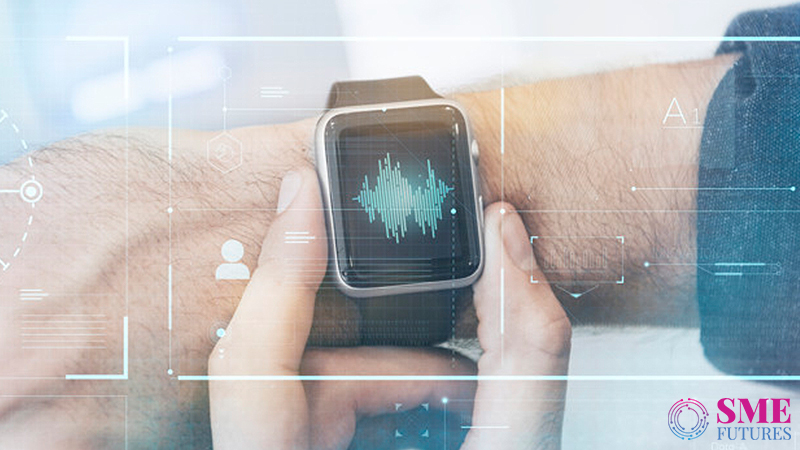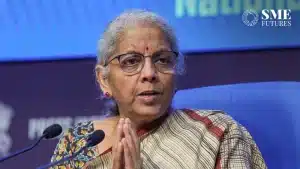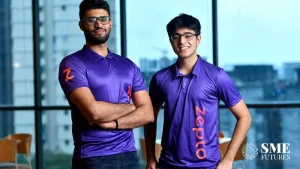A decade ago, nobody could have predicted that one day millions of people would be wearing a watch that not only tells the time but reads messages, plays music, takes calls and tracks their health too! But in just a few years, wearable technology has gone from being non-existent to being omnipresent.
And the sole purpose of these wearable tech devices is to improve and enhance our lifestyles.
However, until recently the wearable tech market was growing at its own pace, with many people showing interest in them but not yet fully aware of the true potential of these devices.
But it seems 2020 has shaken things up quite a bit.
These wearable tech devices are now as popular as mobile devices, and their tendency to get faster and smaller at the same time and their availability in different forms has only added to their appeal. For instance, wearable tech masks have become a thing as have wearable ink stilettos and wearable dog collars. Even CES 2021 highlighted some of the cool innovative wearable tech which further indicates the bright future that awaits the wearable tech industry, globally.
In the new normal of the six-foot space between people, these tech devices have become an agent of change and act as distance keepers, thus people have been noticing them a lot. “Never thought I would ever buy a smart band or a smartwatch before, as I didn’t think of its usefulness. But last year I bought one during the lockdown to keep track of my health. It has many other features as well,” says one user.
Another user adds, “My parents are senior citizens. Seeing the current situation, I bought medical wearable tech to assist in their conditions. We can keep track of as well as get regular notifications about their health, this keeps me tension free.”
Experts consider the rise in remote work and the heightened awareness towards health monitoring and wellness as having created a bigger sales window for these devices, especially those which are relevant to work and health monitoring. Gartner’s Senior Research Director Ranjit Atwal in a statement said that the need to self-track COVID-19 symptoms, along with increasing interest in personal health and wellness, presented a significant opportunity for the wearable tech market.
A strong market
Indeed 2020 heralded a distinct uptick in the global wearable tech market.
Based on the user’s feedback, there is a growing interest in spending on these wearables. IDC’s worldwide quarterly wearable device tracker revealed that the worldwide shipments of wearable devices reached 153.5 million in the fourth quarter of 2020 (4Q20), which indicates a year-on-year increase of 27.2 per cent. Whereas shipments for the full year grew 28.4 per cent to 444.7 million units.
Overall, besides other devices there is a significant jump in spending on ear-worn devices. As per Gartner it was 124 per cent in 2020, totalling $32.7 billion and is forecast to reach $39.2 billion in 2021. This massive growth can be largely attributed to remote workers upgrading their headphones for video calling and consumers purchasing headphones to use along with their smartphone devices.
With this, Indians are definitely exhibiting their love for wearable devices.
This has made India the only country in the top 20 to see triple-digit growth in wearables in 2020, as per IDC. Last year, the Indian wearables market posted a remarkable growth of 144.3 per cent (YoY) with 36.4 million units in shipments. Not only this, with this remarkable growth the country continues to be the third- largest wearables market globally.
Further analysis tells us that like the global market, the major portion of wearable tech growth in India was due to the increased sales of earwear devices and upgrades to watches from wrist bands.
Wherein, earwear device shipments grew more than threefold in 2020 compared to the previous year, mainly driven by the affordable launches, and expanding use cases beyond entertainment like virtual meetings and e-learning requirements. While the smart watch category grew significantly with 139.3 per cent y-o-y with 2.6 million units in shipments. At the same time, wristband popularity shrank with a decline in the wristband segment of 34.3 per cent.
The increasing popularity of watches at comparable price points to that of wristbands is the main factor behind the decline of wristbands. With 46.7 per cent of the market share, Xiaomi continued to lead this category in 2020. Realme, which entered the segment in 2020 finished second with a 12.3 per cent share, states the IDC report.
Anisha Dumbre, market analyst at IDC India said, “Hearables became one of the most sought-after electronic categories in 2020. The newer version of hearables is much better in managing the increased audio usages and improved aesthetic and design also made them the trendsetter.”
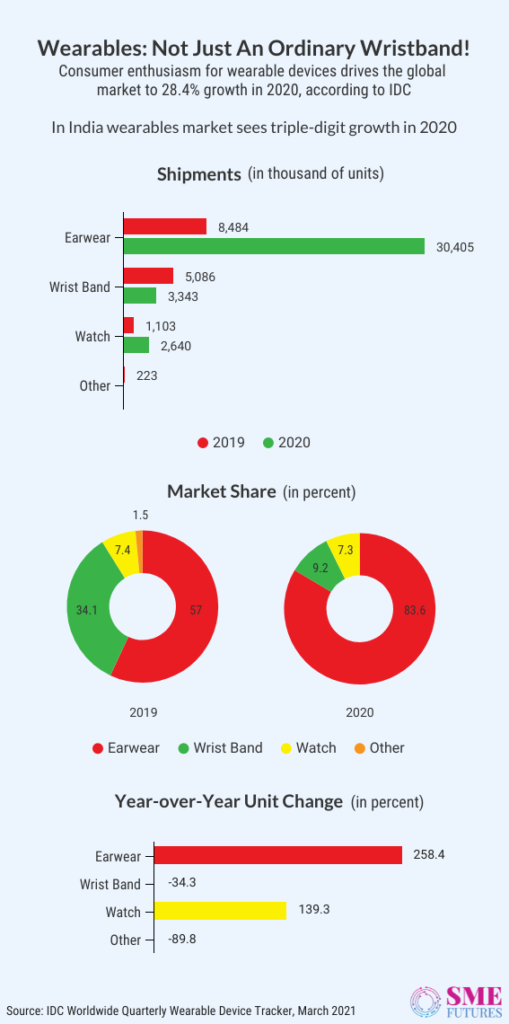
Visibility to domestic players
Being a leader in the technology market, India always catches up with the tech trends as well. With the massive shift in consumer behaviour towards smart gadgets, and a strong millennial base with rising disposable incomes, smart devices and gadgets have received much traction. Given this, the Indian market offers immense growth potential for wearable devices, where Apple is currently leading in the smartwatch category. Other companies such as Fitbit, Realme, Xiaomi, Fossil, Garmin, Samsung are significant names in this arena too.
Meanwhile, Indian players in the wearable segment have also gained a lot of prominence in this sector.
Indian companies such as BoAt and Noise have been leading the charts in the earwear and watches category. As per the IDC report, “Noise led the watch category with a 24.5 per cent share in 2020 followed by Realme with a 15.7 per cent share in the same year. While BoAt emerged as the biggest player in this category, accounting for one-third of the category in shipments.”
This is encouraging for other domestic players in the sector, and companies are coming up with new products each quarter for us to incorporate in our daily lives. We talked to a few of them to find out how they have been faring in the current scenario.
Navi Mumbai based company Actofit, which creates connected ecosystems and wearable gadgets around health and fitness has been witnessing a surge lately. For them 2020 has been a good year but in a surprising way.
Pratik Saraogi, Founder and CEO talks to us, “With the pandemic being a huge part of 2020, we, like many other businesses, took a conservative approach in terms of our expectations. However, what we could not predict is how health conscious and health-focused this pandemic has made consumers, especially those that are from India. The caveat here was that consumers were not only worried about their own health, but a lot of times it was for the health of the people around them (family & friends). This health fear that the pandemic catalysed gave a great boost to our Smartscale (body composition analysis checks) sales.”
With this health consciousness no longer a temporary phenomenon but a permanent one, Saraogi expects this trend to continue in 2021 as well. “This coming year might mark a comeback for some companies who may up their marketing strategies in accordance with the lessons learned from 2020. People will continue to place a higher premium on trust and transparency and companies need to be able to communicate efficiently with their customer base,” he said.
Earphones, earbuds, headphones and smartwatch maker Fire-Boltt is also enthusiastic about the current scenario. The company has been recognised as a top 5 selling brand on the e-commerce platform Amazon.
Aayushi Kishore, co-founder of Fire-Boltt says that the company emerged as one of the frontrunners in the wearable and audio segment during this period. “Our smartwatch with SPO2 features was ranked among the top 4 selling smart watches on Amazon within days of its launch. Other than our fitness wearables and smartwatch, our audio products also did well.”
“Besides that, our global first Boltt Play app (an entertainment-fitness-reward ecosystem), registered an over 1 million userbase within 12 months without any expenditure on marketing. It is because people get premium memberships of platforms like Zee5, JioSaavn and gaana, and earn rewards while watching movies or listening to music and walking or working out. These rewards can be exchanged in lieu of branded products from the in-app store,” she adds.
Another Delhi based consumer electronics and mobile accessory brand Vingajoy has been catering to the needs of connected consumers with its diverse portfolio. With their focus on delivering quality products at a reasonable price, this company aims to target the appropriate markets and gain credibility and trust from their audience.
Lalit Arora, co-founder and CEO, says this has helped them to a great extent in maintaining brand presence in the market in comparison to the other consumer tech manufacturers, even during the economic slowdown. In terms of business, 2020 has brought good traction for them as well. He tells us, “Business has been going well as demand surged during the lockdown. We can say that the WFH culture made the consumer accessory industry work more efficiently towards delivering what their customers want and need. We have been working rigorously to deliver what our customer’s desire. Not only this, but we have also introduced a few covid essential products like – face shields, face masks and sanitizers besides our wearable portfolio. Also, markets are not area specific in the country. Certain remote cities and towns have turned out to be favourable markets for us. A sizeable number of distributors and a variety of products are the major factors behind the diversity in the Indian markets.”
Innovation is trending
Indian consumers always look for variety, style and unique features while looking for products and they being trendy as well is an added bonus for them. This has also been a motivating factor for domestic players, spurring them towards further innovation and research.
Indian companies, in a bid to stay ahead of the competition, are diversifying their portfolios.
Vingajoy’s Arora says, “We keep on doing research to fulfil the demands of the market and continuously strategize to deliver the best-in-class. The best part is that the consumers are gravitating towards the emerging brands and are actively experimenting with our new products. The feedback from their end was quite appreciative and encouraging.”
Likewise, Fire-Boltt’s Kishore sees more opportunities in the market with the diversification of products. According to her, everyone wants to be fit but within their own boundaries. These gadgets are just the right instruments to provide that facility. Meanwhile corporates and companies have started handing out these products as gifts, thus providing more business opportunities.
With this in mind, Fire-Boltt is focusing on new innovations and integrating the latest cutting-edge technology into their products. “We are diversifying the product portfolio taking into account the qualitative aspects rather than running after quantity. However, over the next 3-4 months, we are likely to launch 30 new products, in addition to our existing bouquet of around 60 products,” she says.
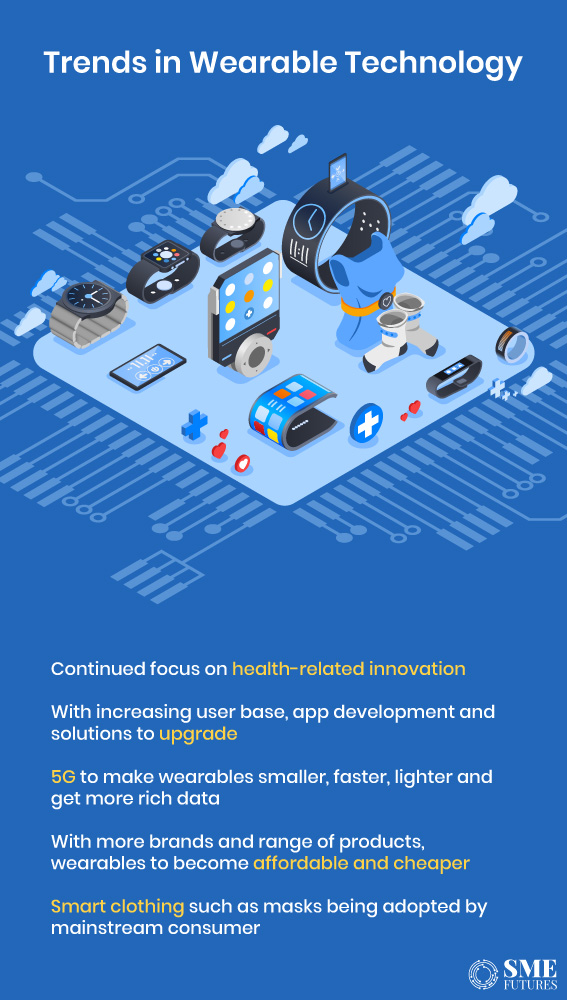
Similarly, based on the latest trends, Actofit’s Saraogi informs us that his company is also working on more gadgets and tech solutions for the market.
“We are extremely excited about some of the products in our pipeline including a cycling cadence sensor, boxing sensor and smart weights. Our Rs 10,000 Smartscale with 99 per cent accuracy is efficient as compared to the Rs 4 lakh Inbody machines. This is just on our hardware side and on the software front we have a few exciting developments happening as well, “he informs us.
Without revealing any more details, he says that these products will provide customers with a smarter, better and more competitive fitness regime while doing workouts, cycling, boxing or gymming.
As wearables are becoming increasingly embedded in our daily lives, be it for work, leisure or medical assistance, the market continues to grow. So naturally, manufacturers are coming up with novel solutions in this category. Livinguard AG, a hygiene tech platform has launched wearable face masks and hand gloves in 2020 based on technology that infuses the textile with a positive charge.
Interestingly, these products are reusable and have clinically proven to be effective against the COVID virus.
“Our masks, ULTRA-V, PRO and STREET, cater to all use-cases and circumstances. They can be reused for more than 6 months; if worn daily and washed weekly, each Livinguard mask effectively replaces 210 single-use masks while remaining cost-effective. Thus, our technology not only protects the user, but also the planet. Our STREET gloves make touching safe again by replacing the need for sanitizers which dry out your hands and submerge them with chemicals,”
says Inventor Sanjeev Swamy, founder and CEO of Livinguard AG.
Available on e-commerce websites such as Flipkart, Amazon etc, since their launch last year, over one million wearable masks have been sold so far. Being a make in India product, the manufacturing unit is in Turbhe, Maharashtra. Swamy asserts that his product aligns with the government’s imperatives. “We have our laboratory and textile processing facilities in Navi Mumbai, while our manufacturing partner is located near Bengaluru. We currently have the capacity to produce 150,000 masks per week in India,” he says.
Swamy also tells us about some other unique applications and quirky products that are currently under development and getting ready for commercialisation and they include bed sheets, surgical towels, lab coats, scrubs, curtains, military fatigues and uniforms, underwear, socks, bakery towels, sanitary napkins, water filter cartridges, paper, plastic and many more.
Meanwhile, companies are also considering innovations backing on consumers’ preferences. For instance, Kishore of Fire-Boltt feels that the new age consumer, especially the millennial, does not want multiple devices, as the idea is to go for all-in-one devices. Consumers today want health trackers, WFH features, call connectivity and leisure all embedded in an all-in-one device.
She further avers, “In the audio segment, Active Noise Cancellation is likely to dominate the trend whereas in the smartwatch segment, innovators are expected to come up with more solutions to capture more health-related data such as ECG monitoring. Taking all these factors into consideration, Fire Boltt is slated to soon come up with an all-new range of products.”
Spotlight on medical wearable devices
Wearable devices have a vast potential to play a key role in observing any unprecedented situation first-hand.
And 2020 had just propelled us to further explore this potential.
Hence, we cannot deny the fact that the wearable tech segment has fired the imaginations and spurred the creativity of various technology makers, giving rise to a whole new gamut of perspectives and products, especially in the medical segment.
The pandemic has brought wearable medical devices into the spotlight. Globally, various companies working on wearable medical products are constantly innovating and creating new devices such as ones which can detect the early warning signals of any viral infection.
For instance, the Swiss product Ava Bracelet, which was primarily a fertility tracker, leveraged their product to help combat the coronavirus. Now this wearable fertility tracker tracks heart rate variability, breathing rate and skin temperature, making it useful in tracking symptoms of the virus.
Similarly, the domestic wearable tech market is increasingly deep diving into the health and medical space.
Commenting on the pivoting of wearable devices, Swamy professes, “People have become more conscious about maintaining a healthy day to day lifestyle; thus, this has led to a big surge in the wearable tech market in India. According to me, textile tech can play a vital role in this segment. Antimicrobial, antiviral and antibacterial solutions for textiles and apparel have been some of the major trends in the wearable tech market.”
As per him, the prospect of empowering textiles with the ability to continuously disinfect even after multiple washes without leaching, offers limitless opportunities to numerous industries and various avenues for the application of these products, from airplane seats to public transport, fashion, and upholstery.
Whereas Actofit, which has been developing wearables in this space, sees it as an opportunity as well as a warning. Saraogi says, “The landscape of the wearables market is changing, and domestic wearable tech players should be cautious of the warning signs. Wearable tech, which started out with reading an individual’s parameters such as calories burnt, distance tracked, heart rate and in our case additional parameters like workout mode and rep counter is now of only half the value that it once used to be. Much more is required from it now.”
However, discussing the current market scenario with the emergence of medical wearable devices, the players do feel that wearable tech and health are not completely overlapping segments of the market just yet.
“What we have seen is that wearable tech such as Fitbit and Garmin are not competing with health and medical wearable devices that give out parameters such as blood sugar levels, blood pressure, etc. Given this divide, what can be expected in the future is an overlap of these two market segments and once that happens, we will see a very evident and strong market sentiment in reaction to that,” feels Saraogi.
As per the market research platform 360marketupdates, the global wearable medical devices market size is expected to gain growth in the forecast period of 2021 to 2025, with a CAGR of 9.9 per cent by 2025. While it is expected to reach US$ 9869.5 million by 2025, from US$ 6758.2 million in 2019.
5G—unlocking of new possibilities and the future ahead
The accessories market is highly competitive in nature, and requires continuous innovation and development, especially in the case of product design and improvement, with changing consumer trends, which is driving the growth of the fashion accessories market. There is a growing contribution to the market from developing countries such as India, owing to the shift in consumer behaviour, growing purchasing power, increasing urban population, etc.
Industry experts do recommend the players in this segment to continue to evolve, whether in terms of strategy, products or innovations.
Kishore comments, “We understand that the need of the hour is to change every challenge into an opportunity. Thus, domestic players like us need to continue innovating, evolving and adopting the latest cutting-edge technology. As a matter of fact, a few home-grown brands in the wearables segment have performed phenomenally well in the recent past and continue to do so as we speak. Someone once said that apprehension and uncertainty cause a patient more harm than any exertion, hence we need to get over our apprehensions to grow.”
Adding to that, Arora of Vingajoy feels that the growing power of the internet, social media and e-commerce are helping brands as well as providing access to the top brands to the consumers in tier 2 and 3 cities. By distribution channel, the market is segmented into offline channels and online channels. Online distribution channels are gaining prominence owing to the wider availability of all accessories at affordable prices. “The pandemic has taught us that nothing is permanent. We are updating ourselves accordingly. Shifting our focus to digital platforms and creating an engaging customer base on social networking sites is our current focus, which we strongly believe will surely help us in the future,” he says.
Meanwhile, the various agencies tracking this growth foresee a strong market ahead.
Seeing the soaring interest in wearable devices, Gartner predicts that users will spend $81.5 billion on these trackers and fitness devices in 2021, up 18 per cent from $69 billion last year. On the same note, research firm Canalys also predicts that the sales of smart fitness bands will surpass 200 million units in 2021.
Meanwhile, soon your wearables are going to be sleeker, smaller and superfast, and may be embedded in your shoes or clothes too!
It may sound sci-fi but 5G optimists are pretty convinced of such a future with wearable gadgets being the norm. Wearables generally come with mobile connectivity and have been upgraded from 3G to 4G. So, it is conceivable that 5G implementation is the next step.
With 5G, wearables will share real-time notifications and mine rich data and insights into our health, surroundings, wellness and goals. In addition, the IoT system will be at the centre of this technology with a multitude of sensors, which will make gadgets more powerful and accurate.
In fact, with 5G connectivity, wearables will be able to compute more, require less charging and will be able to constantly incorporate more advanced features. Eventually, they will even be able to upgrade their software on their own, without needing your cell phone to be nearby.
Ultimately, wearables will one day include AI and data analytics in their software, and the potential for innovation will go through the roof. According to a recent industry report, the wearables market is expected to quadruple by 2022 to 430 million units. Industry feels this will further boost consumers’ interest in various wearables which will become increasingly omnipresent, assisting us in each and every area of our lives.
Thus, wearable devices have vast possibilities that go beyond health and wellness and can conceivably transform into indispensable tools for various if not all industries.

